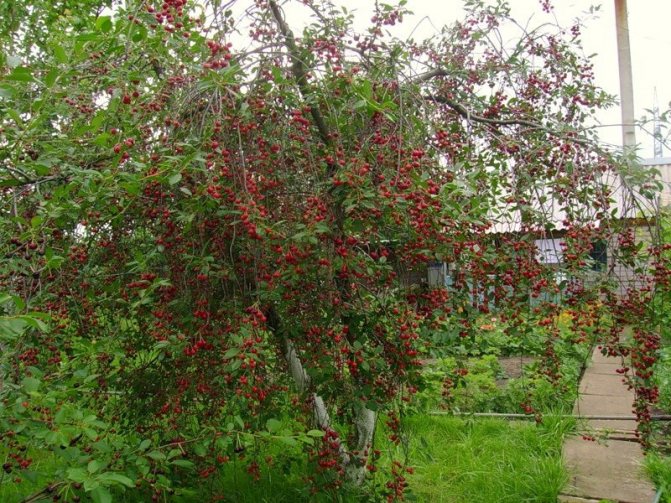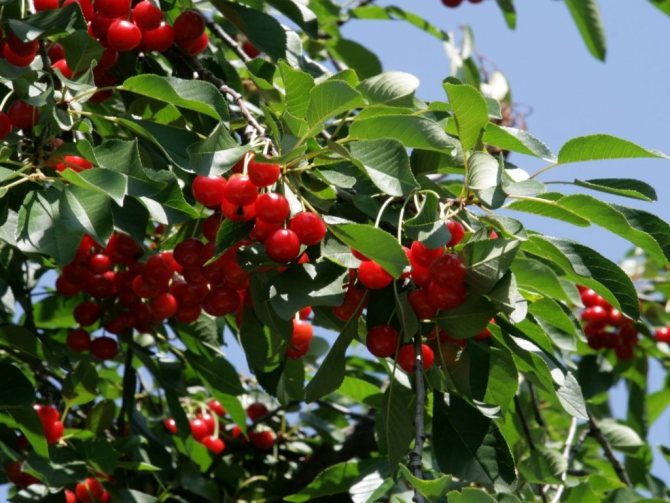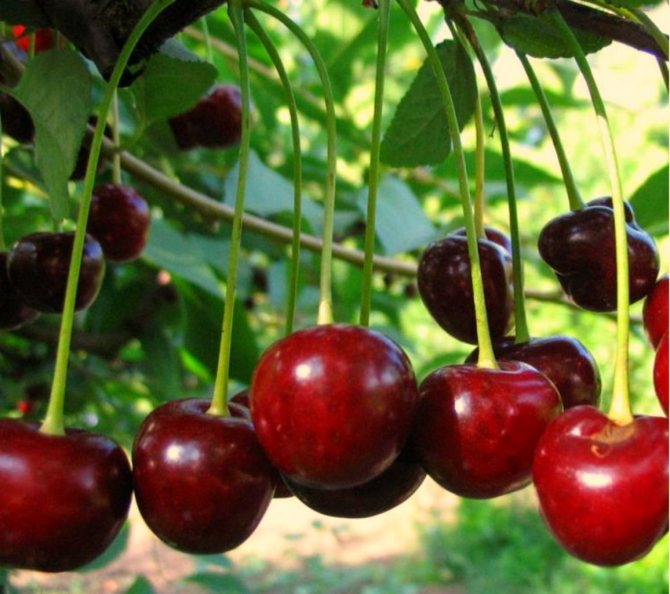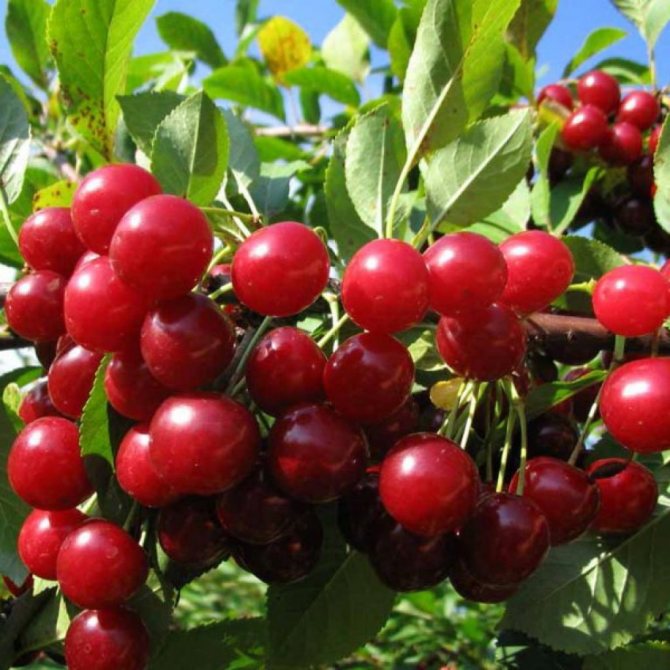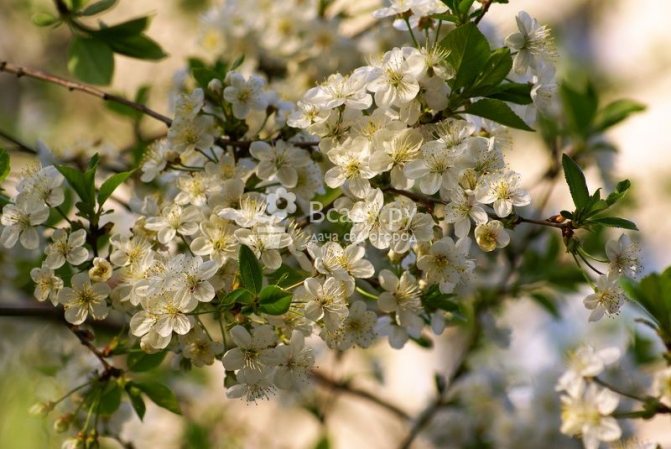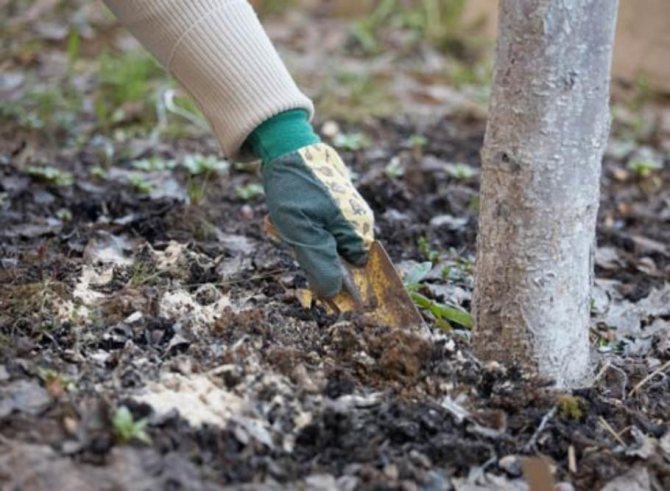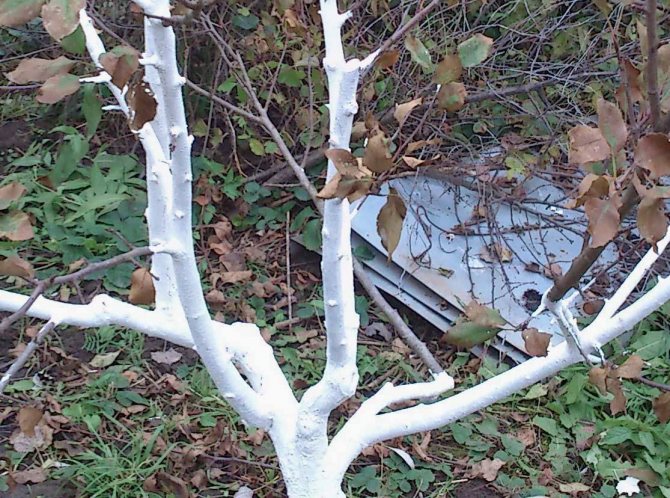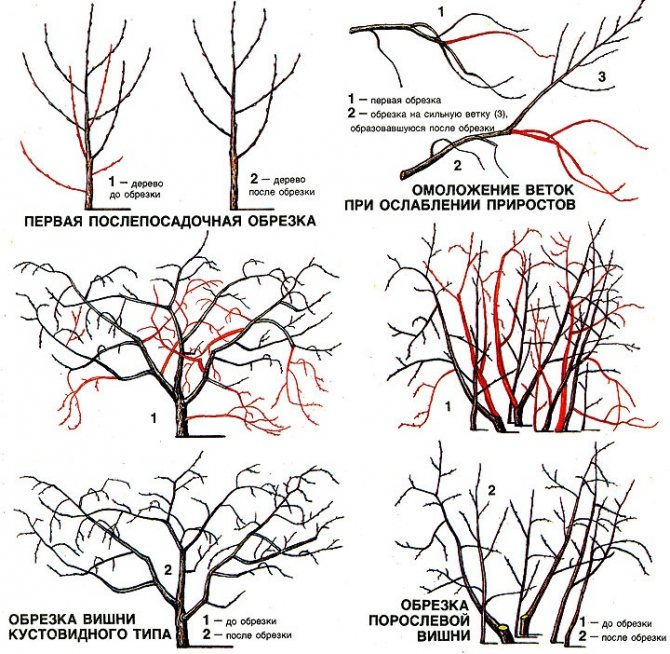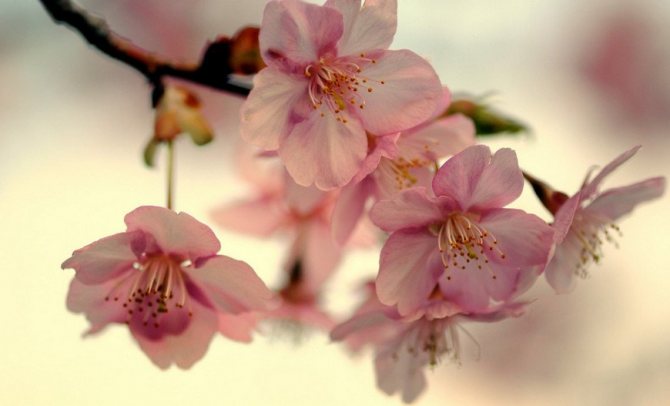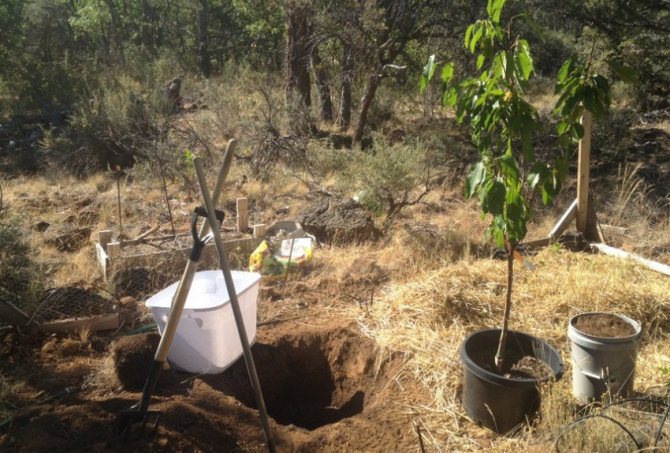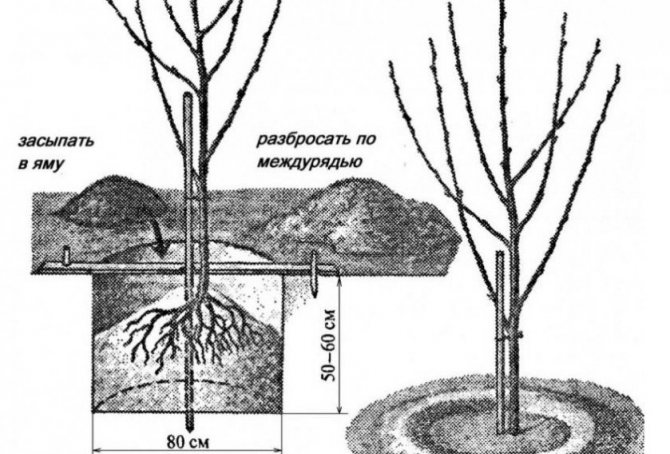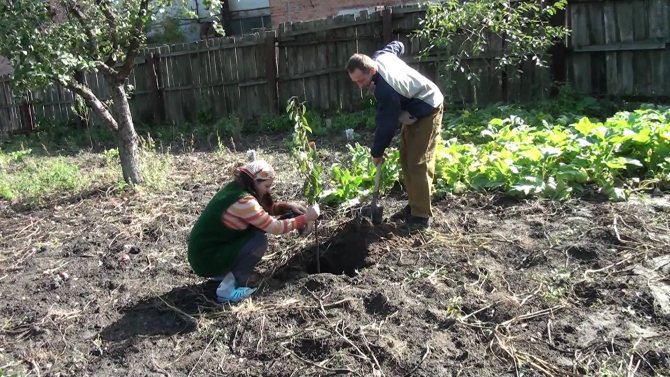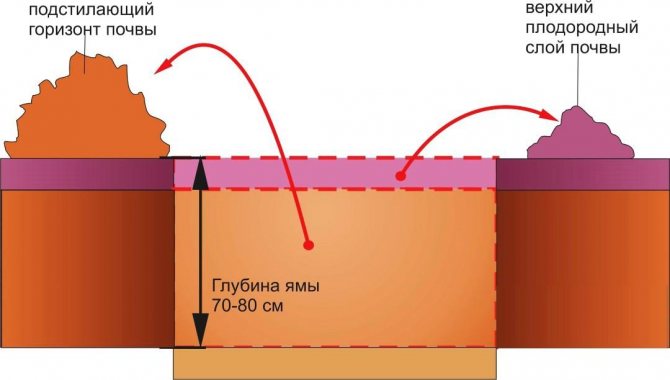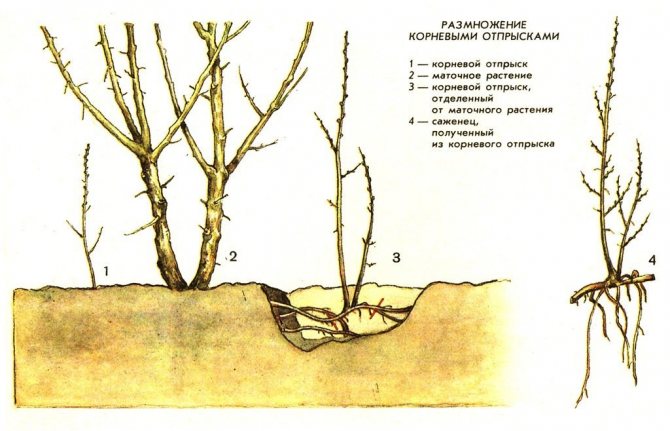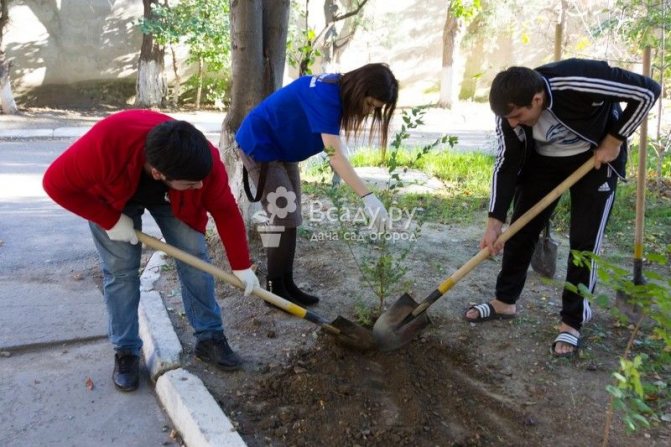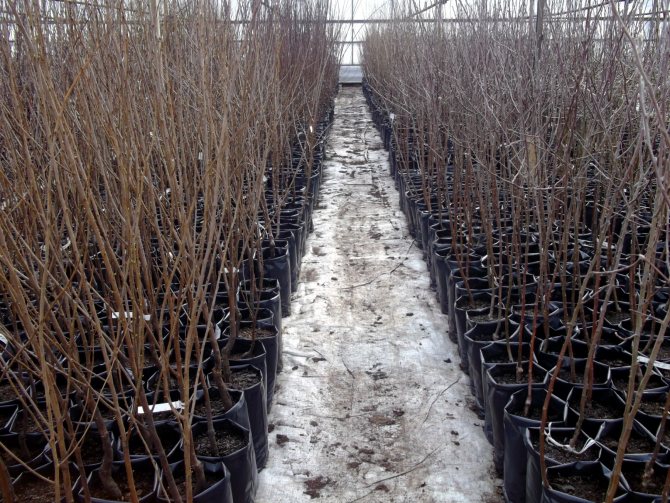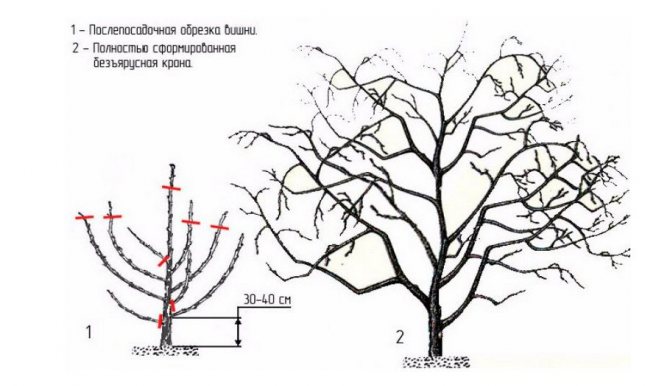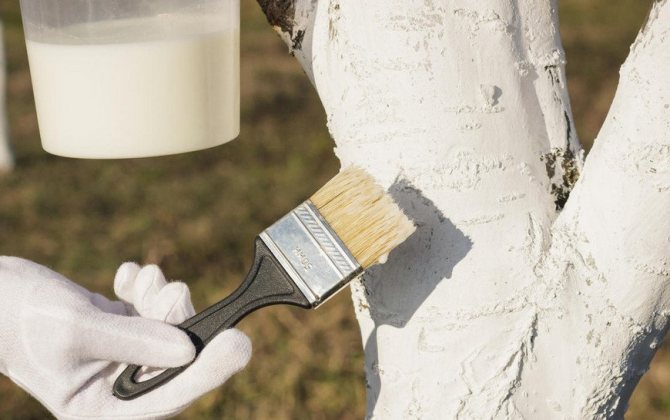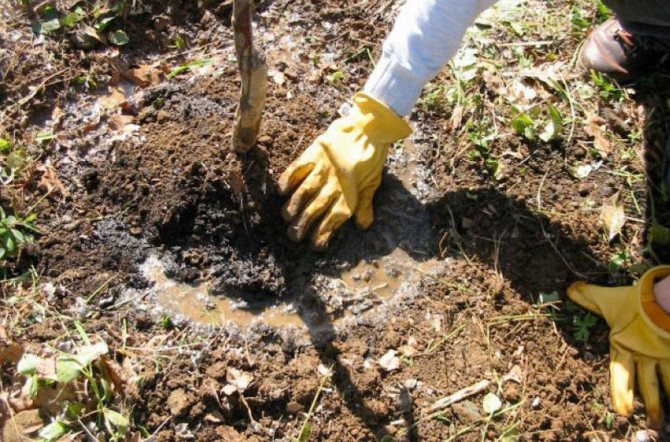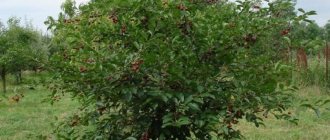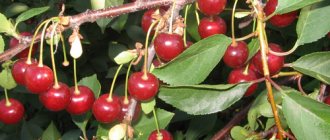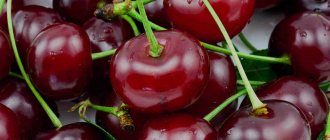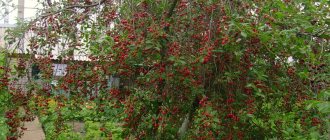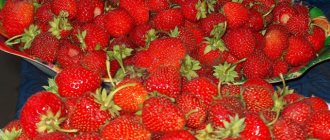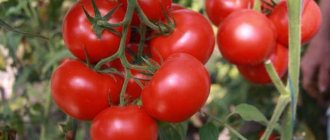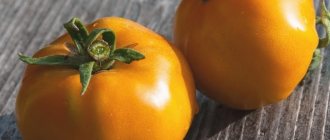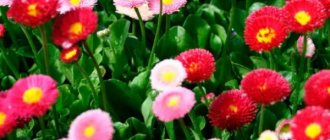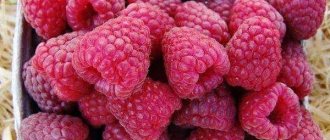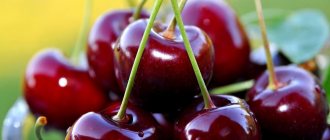Most gardeners are of the opinion that the branches need to be shortened to a crown diameter of 2-2.5 m. In order to prune, you do not need to be a professional gardener, it is enough to take this matter with responsibility.
The top of the cherries should be cut by about 50 cm annually (we are talking about a tree that is more than 4-5 years old).
When pruning, shape the tree in such a way that later it is convenient to harvest the fruits, make room for the stepladder.
You also need to carry out anti-aging pruning, that is, get rid of old branches and shoots. Protecting seedlings in winter In general, the young tree is quite resistant to cold and wind, but the young tree needs to be additionally protected for the winter.
Winter-hardy varieties are Zhukovskaya, Morozovka and Novella.
First of all, we protect cherries from rodents who are not averse to eating cherry roots in the cold season.
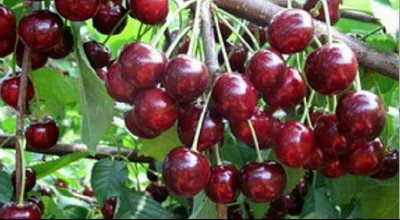
In order to prevent damage to the root system, it is necessary to cover the tree below, or put a fence so that it cannot be approached.
The first method is more relevant, since for a large number of trees it will take a long time to fence in. To provide additional protection, the root is covered with moss.
We recommend watching a video on the correct formation of fruit and berry trees.
Diseases and pests
Youth are not prone to fungal diseases, to which almost all other varieties of cherries that grow in our area are susceptible. But there are still some dangers for this type of cherry.
One of the most dangerous diseases for Youth is moniliosis. This disease is manifested by the gradual drying of cherry branches, the tree can be partially or completely affected.
Cut branches must be destroyed to prevent the spread of contamination to other trees and plants.
There is also such a disease of cherry trees as monilial burn... Getting rid of it is not easy. Monilial burn, as a rule, appears during the flowering period.
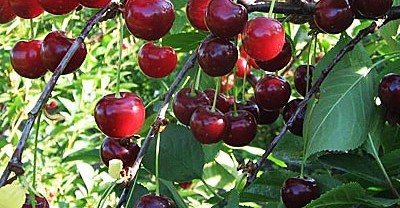

The only way out is to spray the tree with a special solution.
It is necessary to take into account the fact that such a disease spreads very quickly, so carefully check the trees that grow next to the infected cherry.
Leaves on a diseased tree change color very quickly, often it reaches crimson, after which the leaves fall off. In such a situation, fertilizing the tree with nitrogen is required.
There are no particular difficulties in growing youth. Approach this business with responsibility and soon you will have delicious cherry jam, as well as the opportunity to enjoy eating fresh cherry fruits.
If you find an error, please select a piece of text and press Ctrl + Enter.
The main characteristics of the variety Molodezhnaya
Cherry variety Molodezhnaya was bred by breeder Kh.D. Enikeev together with S.N. Saratova. They crossed with each other two varieties of cherries: Lyubskaya and Vladimirskaya. In 1993, the resulting crossing cherry variety was entered in the state register.
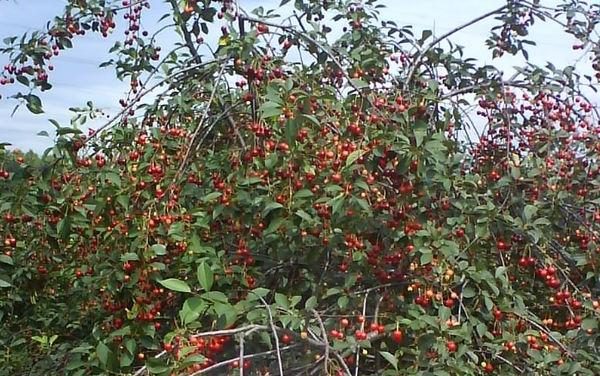

Cherry Youth in the form of a bush
This variety of cherry grows in the central region and in the Urals. Cherry Youth can grow in the form of a tree or bush. A tree or bush grows up to 2.5 meters in height. The foliage of a tree or bush forms a rounded shape, slightly drooping. Leaves are medium in size, bright green in color.
The inflorescences of the plant consist of five or seven flowers, the diameter of which is 1.8-3 cm. The flowers are white, the stamens and pistil are equal in height, which allows the plant to self-pollinate.
Youth belongs to self-fertile varieties. This variety will please you with its fruits pretty soon. Already in the fourth year, the tree begins to bear fruit. And after another four years, vigorous fruiting begins, which lasts until the plant reaches 15-20 years.
Flowering begins in mid-May, and by mid-July you can harvest berries. During the fruiting period, one bush or tree can produce from 10 to 12 kg of berries.
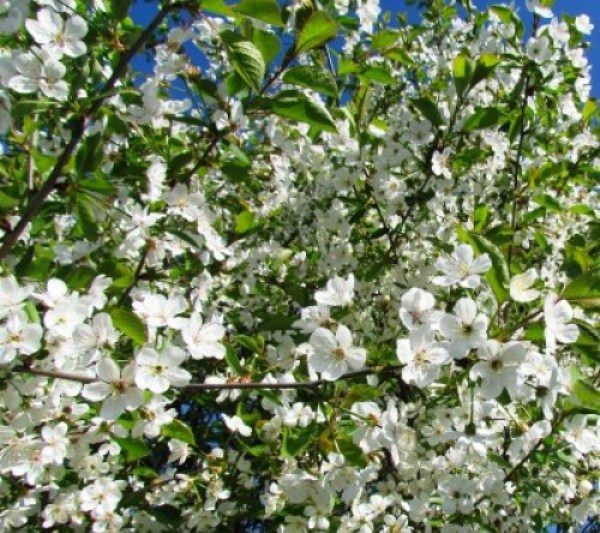

Cherry blossom youth
The Molodezhnaya variety has average winter hardiness. The flower buds are also moderately resistant. This variety of cherry tree has an average degree of resistance to diseases such as coccomycosis and moniliosis, as well as to various microorganisms.
Description of cherry berries
Fruits are formed on the branches of the last year or bouquet.
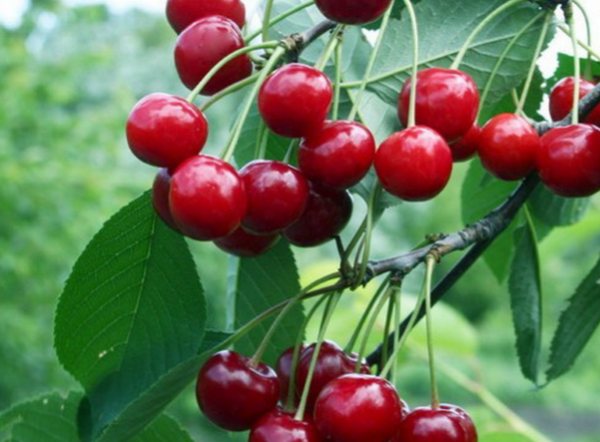

Fruits of the cherry variety Molodezhnaya
The berries have a sweet and sour taste, dense, juicy dark red flesh. Their weight reaches five grams. A medium-sized bone is quite easily separated from the pulp. The berries are oblong. Dense fruits are resistant to transportation and mechanical damage.
The taste of the fruits is dominated by sweetness, so they are often used in the preparation of various dessert dishes. Berries are great for fresh consumption.
Positive and negative qualities
Youth has many positive qualities.
These include the following characteristics:
- good tolerance by flower buds; lower air temperature;
- plant resistance to fungal diseases;
- berries are easy to transport, as they are quite dense;
- self-fertility of cherries allows pollinating neighboring non-self-fertile plants;
- the plant is resistant to a drop in air temperature and to dry periods in summer;
- berries have a large amount of vitamins, trace elements, pectins.
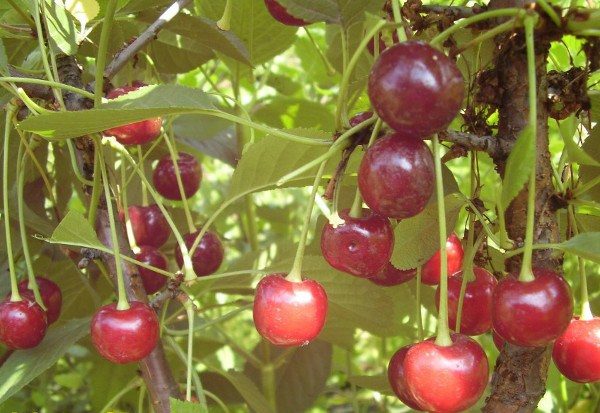

Cherry Molodezhnaya is resistant to fungal diseases
However, along with the advantages, this species has some features that should be taken into account when cultivating:
- every year the plant must be treated with fungicides to prevent various diseases;
- it is necessary to carefully select a landing site, the ideal option is a plain with light winds;
- every year it is necessary to make fertilizing with phosphorus, nitrogen and potassium;
- so that there is no overgrowth, the plant must be cut regularly.
These features of care do not in the least detract from the value of the Youth.
Cherry Molodezhnaya: description of the variety of photos and reviews
Cherry Molodezhnaya is highly resistant to frost and is suitable for planting in the Moscow region and in the Urals. This variety will be an excellent decoration for any garden, and advice from professionals and gardeners' feedback on growing will help you cope with any difficulties.
Experienced gardeners know that if you choose cherry varieties of different ripening periods, you can feast on fresh berries for a couple of months.
Cherry Youth variety description
Cherry variety Molodezhnaya appeared in 1993 by crossing Lyubskaya and Vladimirskaya. A low tree with a height of 2-2.5 m has a round crown of medium density with branches lowered to the ground, which greatly facilitates harvesting. Refers to bushy compact varieties that take up small spaces in the garden.The bark is brownish brown, the branches are thin and curved. The foliage is oval, saturated green, medium in size, the underside is lighter. The umbrella-shaped inflorescence consists of three large white flowers. The flowering period falls in the second decade of May. Differs in high winter hardiness. It is a good pollinator for late flowering cherry varieties.
Cherry description
Variety Molodezhnaya - a variety of ordinary cherries, characterized by high productivity. 10-12 kg of berries are harvested from one adult tree, under favorable weather conditions - up to 15 kg. The ripening period is average, falls on the second - third decade of July.
Fruits are large (up to 100 mm in diameter), weighing 4-5 grams, slightly elongated round, fleshy. They have a dark burgundy color. The pulp is quite dense and juicy, easily separates from the medium-sized stone. The juice is purple, aromatic. The taste is pleasant sweet with sourness, without astringency.
Cherry varieties Molodezhnaya are medium-fruited, bears fruit for 4-5 years after planting. Berries grow on the branches of last year's growth, less often on bouquet branches. With proper care, cherry trees have a lifespan of 15-20 years.
The variety of cherries Molodezhnaya is widespread due to a number of advantages:
- does not require additional pollinators, as it is self-fertile;
- has high frost resistance;
- has a good yield;
- unpretentious to care for, tolerates drought well.
Among the disadvantages of this variety, the average resistance to fungal diseases is noted.
Selection of seedlings and planting
The choice of quality planting material will be the key to a rich harvest in the future. Choose one- or two-year-old cherry seedlings with a height of 70-100 cm, since the young plant will take root faster. Experienced gardeners consider the most optimal planting of a two-year-old, such seedlings have a crown formed by specialists in the nursery. Buy a sapling with leaves to check if the plant is healthy. Please note that the length of the root system must be at least 10 cm. High-quality planting material must be free from damage and signs of disease.
Cherry seedlings should be purchased in specialized stores. Planting is carried out in spring or autumn. Autumn planting material is considered to be more robust and hardy.
Having dealt with the seedlings, you should decide on a place for planting cherries. It is advisable to choose a sunny, wind-protected area that is located on the south or southwest side of the garden. Check the groundwater level, it should be no closer than 1.5 m.Do not plant cherries in lowlands, for this purpose a hill is better suited. Youth, like other best cherry varieties, prefers sandy loam soils with a neutral ph.
Landing is carried out as follows:
- dig a hole 50-60 cm deep and 70-80 cm in diameter;
- fertilizers are applied (humus, superphosphate, potassium nitrate, ash), lime is added to the acidic soil;
- at the bottom of the pit, the dug topsoil 10-15 cm high is laid with a slide;
- a tree is lowered onto a hill and the roots are straightened, a stake is placed next to it, to which a seedling is tied;
- the pit is covered with fertile soil and tamped;
- watering is carried out with soft, settled water;
- the soil is mulched with peat or humus.
The most favorable time for planting cherries is mid-spring or early autumn, since the risk of freezing the plant disappears. Good neighbors for her will be apple trees, cherries, grapes and other varieties of cherries, but planting currants nearby is not worth it.
Cherry Youth: rules of care
Organizing the correct care of cherries will provide you with a rich harvest of tasty and healthy berries.
Tillage
The soil around the cherry is carefully weeded and weeds are removed in such a way as not to damage the roots that lie quite close to the soil surface.
Watering
Cherries tolerate summer heat and drought well, and need additional watering at certain periods: during flowering, active growth, at the stage of fruit ripening and at the end of the season, when the foliage will fall off. Do not allow the soil to dry out during the ripening period of the berries, otherwise this will lead to their cracking. Watering is carried out at the rate of 40-60 liters per 1 sq. M. trunk circle. Make sure that the soil is saturated with moisture to a depth of 40-50 cm. Excess moisture leads to decay of the roots and cessation of growth.
Pruning
Proper and regular pruning is a prerequisite for the growth and development of cherries. It is carried out in early spring before the buds awaken. This will enable the tree to recover before a period of active growth. To form a beautiful crown, a young tree is left with 8-10 branches growing in different directions. Sections are treated with garden pitch.
In subsequent years, branches more than 50 cm long are also cut off old patients. During the fruiting period of cherries, thinning is carried out, removing branches growing inside the crown, which thicken it. This procedure promotes better penetration of sunlight, which will ensure the formation of new fruit buds.
Fertilization
The first couple of years after planting, you do not need to worry about fertilizers, the cherry will have enough of those that were introduced during planting. Further, fertilizers are applied at the following frequency:
- organic (rotted manure) - every 3-4 years;
- mineral (urea) - every 7 years.
Fertilizers are applied to young trees in the near-trunk circle, feeding of an adult garden is carried out throughout the entire plot.
Pollination
Self-fertile varieties of cherries tie up to 40% of the fruits when pollinated with their own pollen. However, by planting another tree nearby, even of a different variety, you will significantly improve fruiting.
Disease prevention
The tree should be regularly inspected for the presence of infected leaves and branches, this will protect the cherry from infection with fungal diseases. If damaged areas are found, they are removed, and the tree is treated with antibacterial drugs (Horus, HOM, Topaz).
Cherry Youth reviews of gardeners
Due to its high yield and excellent resistance to adverse weather conditions, Molodezhnaya cherry is becoming more and more popular among gardeners and summer residents. This variety is especially loved by housewives due to its dessert qualities and a wide range of uses in cooking, as well as excellent taste characteristics and attractive appearance of the fruit. Cherry fruits are consumed fresh, in addition, they are dried, frozen, used to make compotes, jams, preserves, jellies and candied fruits.
The Molodezhnaya cherry variety gives an excellent annual harvest, is highly resistant to frost and drought, is unpretentious in maintenance and will perfectly complement any orchard.
Cultivation of cherries of this variety and rules for caring for it
In order for the plant to please with a rich harvest, it is necessary to properly care for it. An important role in this is played by the choice of the place and time of landing.
Where and at what time to plant?
It is preferable to choose the location for Molodezhnaya cherry on a low hill, which is not blown by the winds and at the same time receives enough sunlight.
It is necessary to plant seedlings either in early spring, or in early autumn (late September). So the plant adapts to the winter cold and overwinters calmly. Later planting dates increase the risk that the plant will not be accepted.
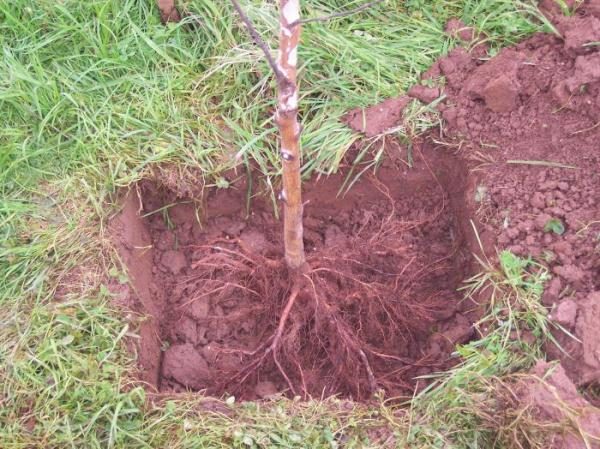

Correct planting of Molodezhnaya cherries
Stages of planting a seedling:
- Dig a hole about 80 cm in diameter and 40 to 50 cm in depth. Place top dressing at the bottom of the hole, which includes: manure, nitrogen and phosphate. A plant with damaged roots should not be planted - it is better to cut them off slowly. Top dressing will help the seedling settle in place better and faster.
- Gently place the roots of the plant in the hole and sprinkle with earth.
- A hole must be formed in a circle around the seedling. Mulching it with humus, sawdust, small bricks or expanded clay. So when watering, the water will be better retained and nourish the root system of the plant.
- Before the first fruiting, it is necessary to carry out the lime treatment of the plant.
When planting a 2-year-old seedling, I need to cut it off. First of all, all shoots that extend at an angle of 90 degrees from the branches are cut off. Next, the "skeleton" of the plant is outlined - three main branches. Around the main branches, all branches are cut, except for those that depart at right angles from the "trunk".
Cherry care rules
Although cherry is a rather unpretentious plant. To get a rich harvest, you must follow some rules in caring for it.
- It is necessary to carry out treatment with special fungicidal preparations annually. This is to protect the plant from various fungal diseases. Particularly careful attention should be paid to this issue if an already infected tree grows next to the cherry.
- It is necessary to regularly apply top dressing to the soil. To do this, in the spring, you need to fertilize the youth with nitrogen fertilizer, and in the fall - with potash and phosphorus fertilizers. Feeding from compost or manure has a positive effect on the growth and development of cherries.
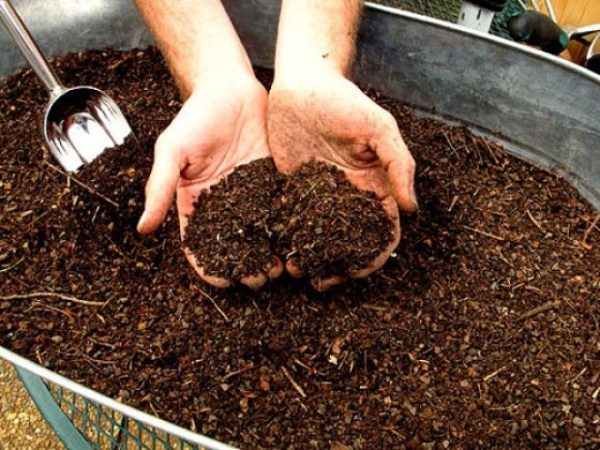

To get a good harvest of the Youth, you need regular top dressing of the soil.
- To improve yields, pruning should be carried out annually. Particularly long branches are cut off and young strong and bouquet branches grow in their place. Berries soon appear on these branches. It is better to keep the height of the plant in the range from 2 to 2.5 meters. This will improve the quantity and quality of the fruit.
- Trimming and cutting cherry tops will provide additional sunlight and prevent crown thickening.
- The plant loves water and needs regular watering. This is especially true during dry summers.
- When preparing a plant for wintering, great attention should be paid to the root system. To protect against rodents and freezing, the roots of the tree are covered with peat or moss.
Read also: Self-fertile cherry varieties with descriptions and photos
If all the recommendations are followed, the plant will delight for a long time with a large and tasty harvest.
How to properly collect and store cherries
Harvesting should start from the twentieth of July. The fruiting period ends in August.
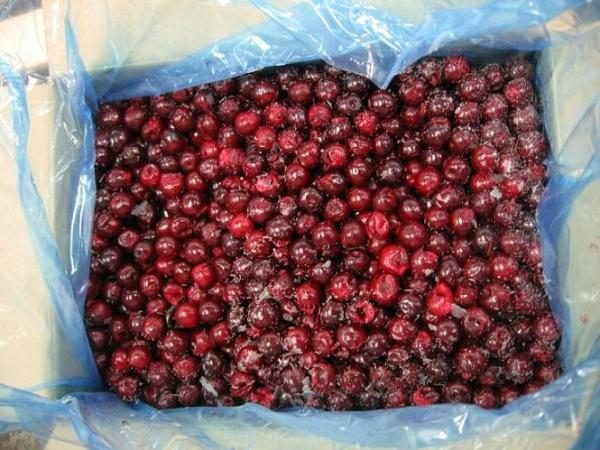

Frozen cherry grade Molodezhnaya
In order for the berry to be kept fresh for a long time, it must be carefully sorted. Only dense berries are left for storage, without external damage, the color of the stalk is green. Cover the prepared container (tray, box) with paper. Put the berries on the bottom. In this case, the layer of berries should not exceed ten centimeters. Remove the container with berries and store in the refrigerator. The temperature should be between 0˚C and + 2˚C. In this form, the fruits are stored for two weeks.
You can also make a variety of compotes, preserves, jam or cherry jams and enjoy them all year round.
New cherry variety Molodezhnaya: detailed description
One of the most common horticultural crops is cherry. Its fruits are amazingly suitable for all types of homemade preparations, as well as freezing and fresh consumption. A typical representative of the garden cherry is the Molodezhnaya variety. Delicious juicy berries and unpretentious care will help you grow the perfect tree on your site. Our article will tell you more about the main secrets of planting and further care for this variety.
Description of the variety
Relatively recently, this cherry was included in the register of varieties of fruit trees. It happened in 1993, and the hybrid itself was obtained by crossing two magnificent varieties: "Vladimirskaya" and "Lyubskaya".The variety is perfectly adapted to the climate of the Middle zone and is widespread in many regions of Russia, Ukraine and Belarus.
The main characteristics of the variety:
- The height of the tree is only 2 - 2.5 meters.
- The crown is voluminous, with falling branches, needs thinning.
- The average yield is from 10 to 12 kilograms of berries from one tree (as well as from Shokoladnitsa cherries).
- The berries are small, intense red in color, the flesh is juicy with a characteristic sourness.
- The variety belongs to dessert, universal purpose.
- The average weight of the berries is 4.5 grams, the skin is thin.
- Ripening occurs on average in mid-July.
- Frost resistance of the culture is medium.
- The variety has an average resistance to most typical diseases.
- The berries are distinguished by good transportability.
- The stone is small, easily detached.
- The variety is characterized as self-fertile and can be an excellent pollinator for other cherry species.
The video shows a description of the cherry variety:
According to expert estimates, the Molodezhnaya variety deserves 4.5 points out of the maximum five. The pulp is rich in color, with a characteristic sourness and very juicy. At the same time, the sugar content is much higher than similar varieties, which is why these berries are so in demand for home preservation and for sale.
By the way, cherry flesh is quite dense, even despite its thin peel, it perfectly withstands transportation and storage. This is of particular interest not only for individual farms, but also for commercial cultivation. But what a Zhukovskaya cherry looks like, and how big its fruits are, you can see in the photo.
How and when to plant
When planting cherries, the condition of the purchased sprout is of great importance. Be sure to check the rhizomes, they must be fresh when cut, without visible damage and dry areas. The bark of the tree should also have a uniform color, the branches should bend well. It is advisable to purchase seedlings from trusted nurseries or from reliable suppliers to avoid disappointment.
The variety "Molodezhny" is widespread, so there should be no difficulties with the purchase.
Landing algorithm:
- This crop grows best on slightly alkaline and neutral soils, so sometimes liming will be necessary.... It is advisable to choose a place on a hill with a high level of groundwater. For better ripening of the crop, it is necessary to provide free access to the sun's rays, so too closed areas of the garden or location near large trees and buildings will not work.
- It is best to purchase and plant a seedling in the spring. Under favorable conditions for the next year, it is already possible to assess the quality of the fruits.
- The planting hole should be approximately 40 x 80 centimeters in size.
- It is necessary to pour humus at the bottom of the hole, which is then mixed with the ground so as not to burn the root system... You can also additionally use mineral dressings. The fertilizers applied during planting should be enough until next year.
- The rhizomes are well straightened and set in the hole. The root collar should protrude above the ground, and also be oriented to the south.
- The ground at the roots is carefully tamped, and the planting site is well moistened.
But how it is necessary to plant Morozova's dessert cherries, and what the height of the tree is, is described in great detail in this article.
In the video - planting cherries:
As for the formation of a plant, it is possible to perform this in a bush version. The only drawback of such shoots is the rapid spread of root growth, so it is necessary to regularly thin out the thickets. The formation of a standard tree is also possible, in this case there are no problems with harvesting, and neat cherries become a real decoration of any site.
But what the Brusnitsyna cherry looks like can be seen in the article by the link.
It will also be interesting to learn about the peculiarities of growing Ashinskaya cherries.
It is worth paying attention to what columnar cherries and sweet cherries exist, and only after that choose a seedling for yourself
It will also be useful to learn how to save cherries from aphids, and what chemicals should be used in this case.
Further care rules
In the first year after planting, the seedling practically does not require attention to itself. The main thing is to water it on time, loosen the soil at the roots and quickly respond to a possible threat from pests or diseases. Despite its compact size, the tree is surprisingly viable, so it does not cause much trouble to the owner.
The only precaution is that during harvesting, you cannot climb a tree or tilt the branches too much towards you. This is very traumatic for sensitive shoots and the next year you can not count on a good harvest.
Important measures for growing:
- Active watering is necessary for cherries throughout their growth, but it is especially important during the period of budding and fruit formation... Lack of moisture will lead to a decrease in the quantity and quality of the crop.
Features inherent in the Molodezhnaya cherry variety
- Even if you plant only one plant of this type on the site, the harvest will be obtained in one hundred percent of cases. This is due to the ability to self-pollination and the successful structure of the flowers - the pistil and stamens are of equal height.
- When planting a seedling with its own roots, the harvest will be 3-4 years old. And with proper grafting of the tree, berries can form even earlier than this date.
- Excellent resistance to various fungal diseases.
- A negative feature is the accelerated overgrowth. Therefore, it is necessary to remove unnecessary branches in a timely manner so that sunlight is not obscured.
Advantages and disadvantages of "Youth"
This variety has many positive qualities. These include:
- excellent resistance of flowers and ovaries to temperature drop;
- cold resistance (withstands frosts of the middle band);
- excellent resistance to fungal diseases;
- convenient transportation of berries due to their density;
- resistance to dry summer periods;
- the abundance of valuable elements in the fruit.


Cherry treatment for diseases
An important advantage is self-pollination and a successful flower structure: the pistil and stamens are located at the same height. This allows you to get one hundred percent harvest, even if the cherry tree is the only one in the garden. Otherwise, the cherry will be able to pollinate the nearby non-self-pollinating plants.


A bountiful harvest can be expected three years after planting.
When planting a seedling with developed roots, fruits will appear in large quantities after 3-4 years. And if you plant the tree correctly, you can expect a bountiful harvest earlier.
The slight capriciousness of cherries is ranked among imperfections. "Molodezhnaya" needs a careful selection of the landing site (it should be flat, without strong winds). It must be sprayed every year with fungicidal preparations to prevent diseases and apply phosphorus, nitrogen, and potassium supplements. The biggest disadvantage is the accelerated overgrowth. The tree needs to be pruned systematically.
Exposure of young cherries to diseases and pests
Youth, unlike many other varieties of cherry, is resistant to fungal diseases.
The most dangerous disease for this variety is moniliosis. With this disease, the branches gradually dry out. In this case, the plant can be either completely affected by this disease, or its individual parts.
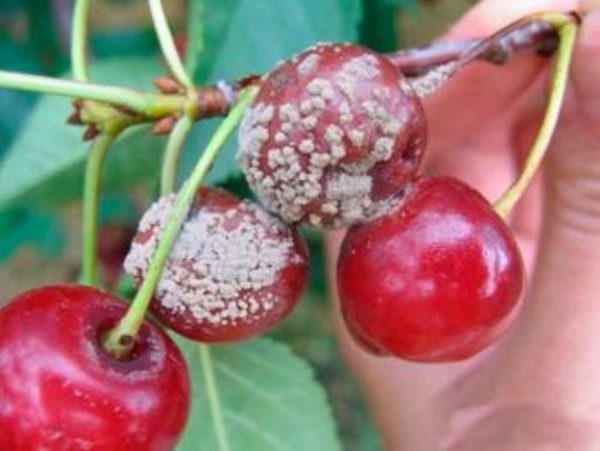

Cherry fruits Molodezhnaya affected by moniliosis
When establishing this disease, it is necessary to cut off all diseased branches with an indentation of 15-20 cm to the healthy parts of the branch. Cut branches must be disposed of in order to prevent the spread of the disease.
Cherry youth is subject to monilial burn, which appears during the flowering of flowers.To cure it, it is necessary to spray the leaves of the plant with a special solution. This disease also spreads quickly, so you need to carefully monitor the nearby trees.
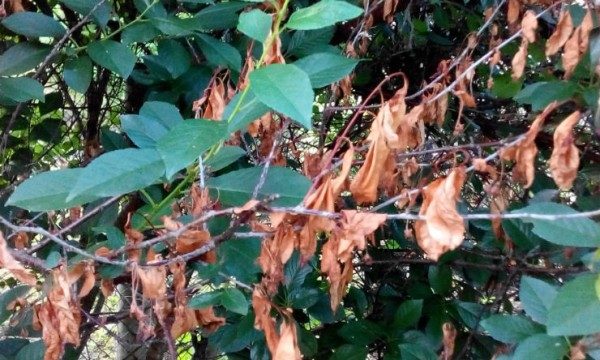

Cherry Molodezhnaya affected by monilial burn
When yellow leaves appear on the plant, more attention should be paid to it. Especially if the color changes quite quickly and the leaves turn purple. This may signal a disease or a lack of nitrogen fertilizer in the soil.
Diseases, pests and control measures
Although the resistance of the Molodezhnaya variety to fungal diseases is not the highest, this cherry still wins very much in comparison with others. Coccomycosis does not parasitize your tree with preventive fungicide treatments. Consider the diseases that most often manifest in this variety.
Table: stone fruit diseases and control measures
| Disease | Symptoms of manifestation | Control measures | Prophylaxis |
| Cytosporosis | Spots and cracks in the bark, leaves curl and fall off |
| Treatment with Novosil; whitewashing of the trunk and main branches. |
| Red spot | On the leaf plates, spots of a light red hue can be seen, then the leaves die off and fall off. The frost resistance properties deteriorate. |
| Loosening of the trunk circle, removal and burning of fallen leaves. |
| Moniliosis | Light gray spots-growths on the bark, shoots and fruits are affected |
| Remove fallen leaves and fruits. Be sure to prune diseased and dry branches. |
| Gum therapy | Bright yellow liquid on the tree trunk, like resin, the tree dries up and dies | In places of damage or wounds, it is necessary to treat with copper sulphate, then with garden varnish. | Protect the tree from mechanical damage, whitewash the trunk and branches. |
Photos of symptomatic signs of cherry diseases
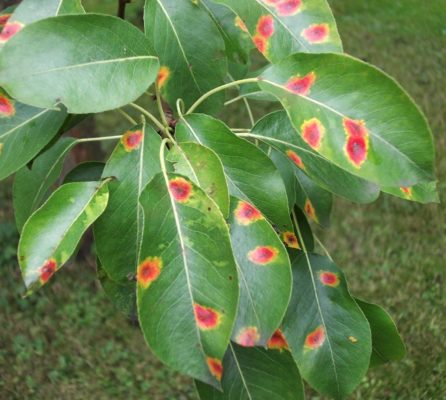

Red spots on the leaves are nothing more than a fungal disease
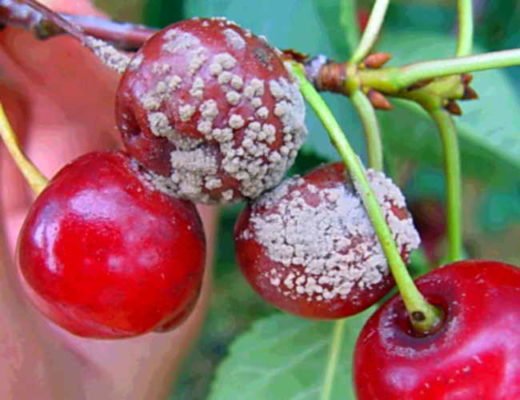

Moniliosis on fruits is manifested by a gray fungal growth, fruit decay
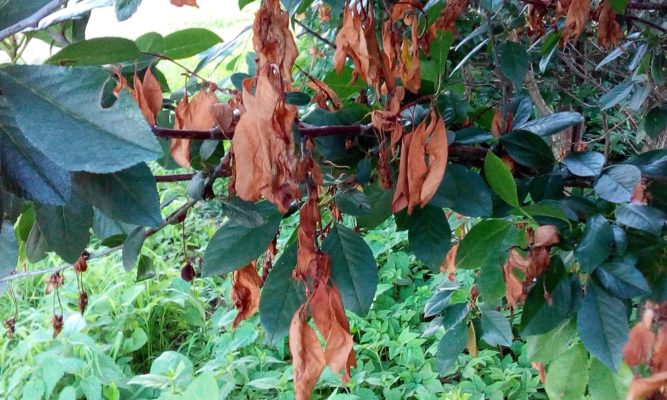

Cherry moniliosis or monilial burn manifests itself as scorched and shriveled leaves that fall off over time
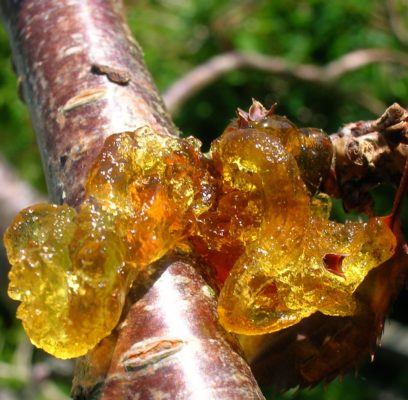

Cherry gum can lead a tree to death
Table: pests of the cherry orchard and control measures
| Cherry aphid | Twisting of the leaves, the appearance of red or burgundy spots on them with tuberosity, when the leaf unfolds, you can notice small green, white or black insects, as well as their larvae | Treatment with the Fufanon insecticide preparation at the rate of 10 liters of water per 10 ml of the drug in ampoules, for one bush up to 1.5 liters of solution; The Spark preparation (50 g per 5 liters) is good because it contains potassium, which is so necessary for a weakened plant; Fitoverm - based on 100 grams per 10 liters of water | It is necessary to get rid of all anthills on the site, since ants are carriers of aphids. It is also good to use sticky belts on the tree trunk (made of paper coated with sticky liquid), because aphids and ants climb to the leaves from below along the trunk. Fitoverm (drug) is perfect as a prophylaxis, it is organic and does not cause any harm to humans and beneficial insects |
| Cherry fly | Small black specks on cherry fruits, berries rot over time | Treatment with Actellik at the rate of 20 grams per 10 liters of water or Fitoverm (1 ampoule per 10 water) | Spraying with Fitoverm in early spring |
| Cherry Slime Sawfly | Black larvae can be seen on the leaves, subsequently an adult appears, which damages the leaves, shoots | Treatment with Confidorm (1-2 g per 100 ml of water) is a strong insecticide, working volume 10 liters | Digging and loosening the soil near the tree trunk (eliminates the larvae and pupae of the sawfly), as well as with the mass appearance of larvae, spraying with insecticides |
| Cherry shoot moth | Damage to young leaves, shoots do not develop | Similar to cherry fly control measures | Burning old fallen leaves, loosening the trunk circle |
Photo of pests of cherries Molodezhnaya
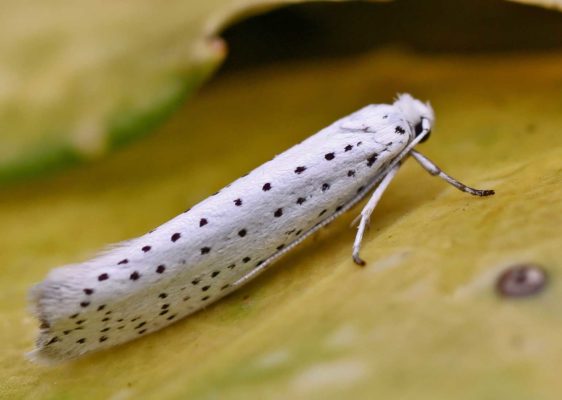

The moth eats up leaves and destroys young shoots.
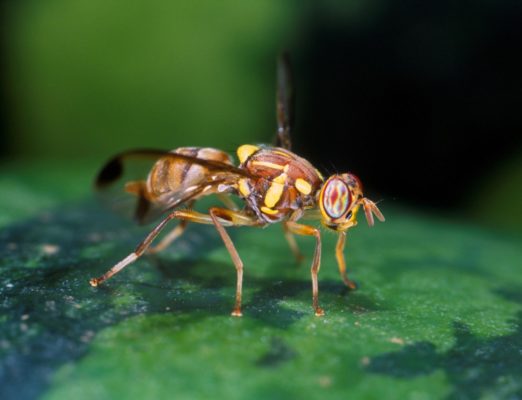

A fly on a cherry lays the larvae that destroy the fruit
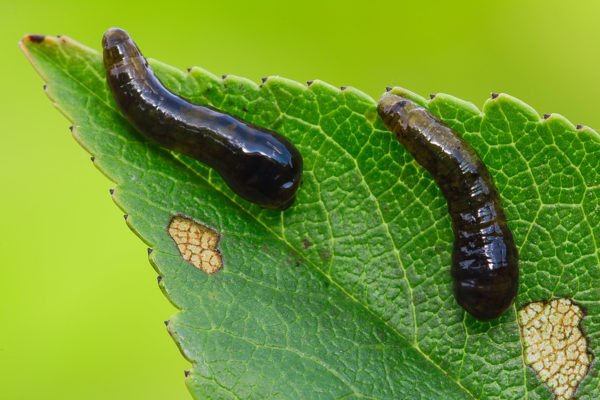

The sawfly is named so for a reason, it eats leaves and shoots
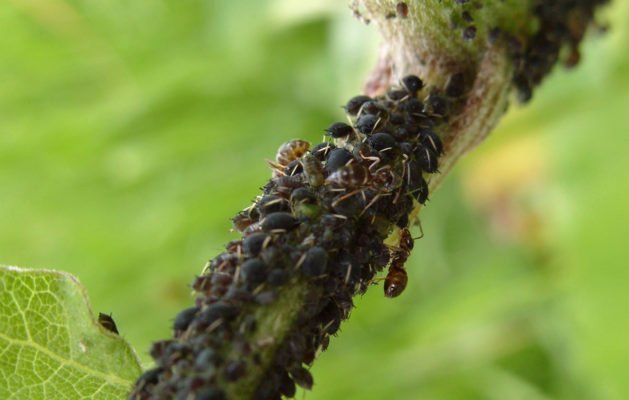

Aphids are very dangerous despite their tiny size, they can destroy the tree.
Reviews of amateur gardeners about Youth
Vladimir: The berries of the Youth are ripe in my garden. I liked it very much! The taste of the berries pleased, more sweet than sour. The only drawback is the height of the bush, only 50 cm from the ground.
Nikolay: Raised Youth near Shokoladnitsa. I have never seen so many berries in a season. The trees are literally sprinkled with cherries!
Mikhail: Molodezhnaya is very familiar with the variety. A large number of positive properties. The plant is fruitful, self-fertile, tolerates winter well. The berries hang on the bushes for a long time and do not crumble.
Cherry varieties Molodezhnaya are the favorite of a large number of summer residents. The plant is distinguished by high productivity due to self-fertility. It is even cultivated on an industrial scale.
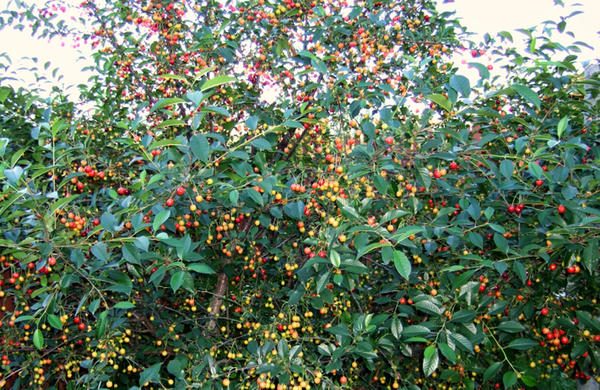

Cherry orchard, unripe cherries Molodezhnaya
The berries are large, with dense and juicy pulp, perfectly stored and transported.
There are no complex nuances in the cultivation of this variety. It is enough just to get down to business with responsibility and love, and a rich harvest will soon be provided.
Features of the variety
This variety was obtained as a result of crossing Lyubskaya and Vladimirskaya cherries. It was entered in the state register in 1993. This species prefers the climate of central Russia and the Urals, can grow by a bush or tree, reaching 2.5 meters.
The crown of a bush or tree is round in shape, the foliage droops a little. The latter are medium-sized bright green. Five or seven flowers, ranging in diameter from 1.8 to 3 cm, are combined into inflorescences. The petals are white, the pistil with the stamens are at the same height, which is beneficial for self-pollination.
Cherry belongs to self-fertile early ripening varieties. The tree begins to bear fruit at the age of four. After another 4 years, the cherry enters the phase of active fruiting, which lasts up to 20 years.
Flowering begins around May 15, after two months it is already possible to harvest. From one bush or tree, you can get up to 12 kg of fruit.
This variety has average frost resistance. Flower buds are also moderately resistant. This cherry variety has an average resistance to moniliosis and coccomycosis, as well as other microorganisms. The development of diseases is provoked by a warm and humid environment.
Description of berries
Fruits appear on last year's branches or bouquet. Dense, oblong-shaped berries have a sweet-sour taste and dark red juicy flesh.
Due to their dense structure, the berries are well transported and resistant to mechanical damage. Each berry weighs 5 grams. Medium stone is easily separated from the pulp.
Cherry berry is very useful, it contains vitamins, organic acids, as well as trace elements, in particular, potassium, phosphorus.
The fruit tastes more sweet than sour, so they are often used to prepare a variety of desserts. The berries are tasty and fresh.
Description of the characteristics of the variety
The plant of this variety has the following characteristics:
- Even one plant of this species, planted in the garden, is capable of producing 100% of the yield. This is due to self-pollination, since the pistil and stamens are at the same height.
- If you plant a seedling with roots, you can get a harvest from the age of four.And if the tree is grafted correctly, then the berries can be obtained even earlier.
- The variety is well resistant to various fungal infections.
- The negative point is the accelerated overgrowth of the crown. To prevent this, it is necessary to carry out pruning in a timely manner, this will allow sunlight to penetrate into the tree.
Positive and negative characteristics of the variety
Youth cherries have many positive qualities:
- flower buds are resistant to temperature drop,
- due to good immunity, the plant is not susceptible to fungal diseases,
- dense structure allows you to transport berries from one region to another without problems,
- self-fertility of the variety helps to pollinate other non-self-fertile varieties.
- tolerates a drop in temperature and dry periods in summer.
- berries are filled with vitamins, minerals, pectins and other beneficial substances.
Read also: Dwarf cherry (undersized): varieties for the Moscow region, winter pomegranate, planting and care
But along with the positive characteristics, the variety also has certain disadvantages that must be taken into account:
- every year, in order to prevent diseases, the plant is treated with fungicides.
- youth cherry is demanding on the place of growth, the best option would be a plain where gentle winds blow,
- each year should be fed with solutions of phosphorus, nitrogen and potassium.
- to prevent overgrowth of a bush or tree, regular pruning should be done.
These disadvantages will not be inconvenient and will not diminish the value of the variety.
Storage of berries
In order for the fruits to be kept fresh for a long time, careful sorting is required. They choose only dense berries, without external damage, with a green stalk. For storage:
- Prepared containers (tray, box) are covered with paper.
- Fruits are laid out on the bottom in a layer of no more than 10 cm.
- Place the container with the berry in the cold, so that the temperature is from zero to two degrees Celsius.
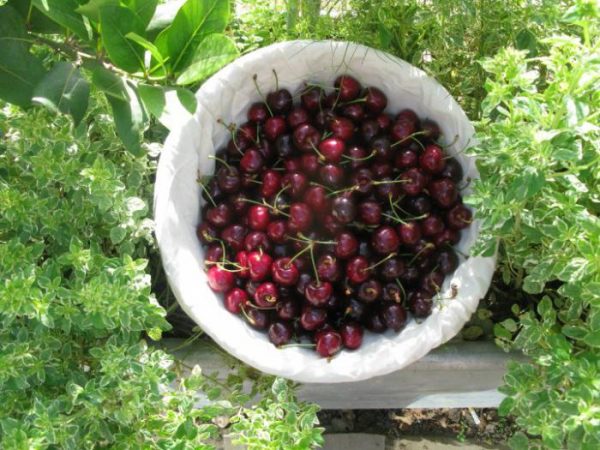

Only dense berries are chosen for storage.
In this form, the fruits can be stored for 14 days. Instant freezing increases the storage time from three months to six months. You can also make seaming: cherry compotes, preserves, marmalades or jams, and enjoy them all year round.
To obtain an excellent harvest, it is required to observe the agricultural techniques of planting and care. In addition, carry out preventive work against diseases and pests.
Planting and caring for youth cherries
In order for a tree to provide a good harvest, it must be properly cared for. An important role in this matter is played by the place and time of landing. When and where to plant a bush or tree? It is preferable to choose a low and well-lit hill without strong winds for landing. The soil for the seedling is preferable sandy loam neutral reaction. It needs to be planted in early spring or late September so that the plant has time to adapt to winter.
Stages of planting a seedling:
- Dig a hole with a diameter of about 80 cm and a depth of about 45 cm. At the bottom, spread a top dressing consisting of manure, nitrogen and phosphate. Fertilizers will help to settle down faster. If the plant has a damaged root system, it is corrected by pruning.
- The roots of the tree are carefully lowered into the hole and covered with earth.
- A hole is dug around the planted seedling. It is mulched with a mixture, which includes: humus, sawdust, small bricks or expanded clay. This will help to linger when watering and how to water the plant. It is important to keep the soil loose near the young tree.
- Before fruit formation, the plant is treated with limestone.
- When planting two-year-old youth cherries, you must immediately prune. First, all shoots growing at right angles from the branches are cut off. Then three main branches are outlined - "skeleton", all branches around them are deleted.
How to care
Young cherry is considered unpretentious, but in order to get a rich harvest, you should adhere to the basic rules for caring for it:
- Treatment with fungicidal preparations should be carried out annually, which will help prevent fungal diseases. Especially if an infected tree is growing nearby.
- Fertilize the soil regularly. In the spring they are fed with nitrogen fertilizers, and in the fall - with phosphorus and potassium fertilizers. The variety responds well to feeding from manure or compost.
- Pruning is important every year to maximize yielding performance. The longest branches are cut, and in their place strong bouquet shoots grow, on which fruits soon appear. The height of the tree is adjustable within 2-2.5 m. This will improve the quality and quantity of berries. Pruning helps make room for sunlight to enter.
- The variety needs regular watering, especially during dry summers. However, it is important to be careful to prevent root rot.
- When preparing a tree for a dormant period, you should take care of the root system. It is covered with peat or moss to prevent freezing and to protect it from rodents.
These recommendations will help the plant to produce a rich and tasty harvest for longer.
The subtleties of the correct planting of a tree
The quality of the future harvest largely depends on the correctly chosen planting site. Therefore, it is important to consider the following:
- Cherries should be placed in a well-lit area protected from cold winds.
- It is advisable to select a place with light sandy loam soil, but if this is not possible, the tree can also be planted in loamy or sandy soil.
- Low-lying areas should be avoided. In such a place, melt water accumulates, and the plant is also exposed to the north wind.
- The acidity level of the soil should be neutral.
- You should not choose a place where groundwater occurs above 1.5 m from the surface.
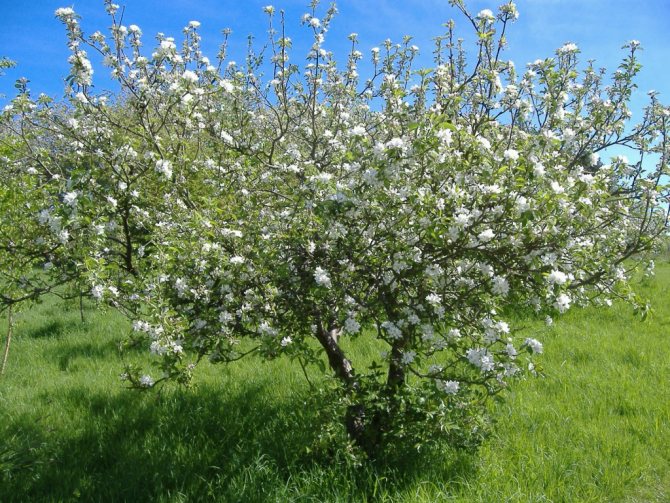

Cherry grows well in a sunny and calm area
An annual or biennial plant with a height of 70 to 100 cm is suitable for planting. Signs of a healthy seedling:
- The root system has a length of 10 cm without dry areas.
- The surface of the trunk and branches is integral (the presence of damage and ulcerative formations is unacceptable).
- There are leaves on the seedling.
So that the plant does not suffer from dehydration, after purchase, the roots should be wrapped in a damp cloth, and then in a film.
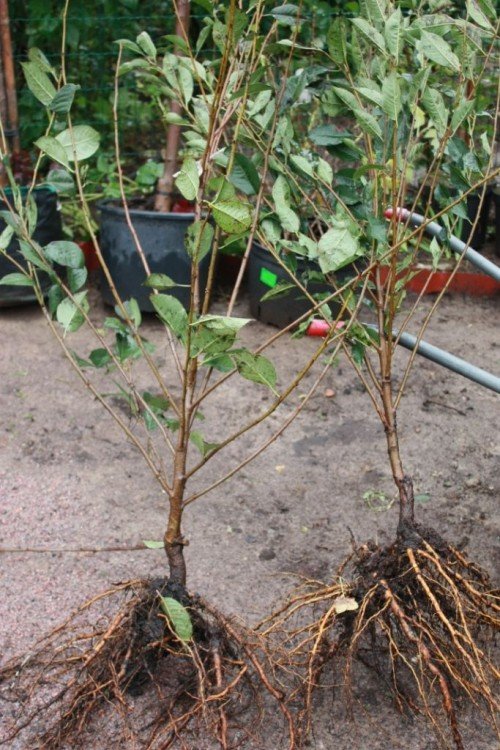

Healthy seedlings are the key to a stable harvest
If a seedling is purchased in the fall, and planting is planned for the spring, it needs to be dug in. To do this, gardeners perform the following manipulations:
- In a shaded place, a pit 30 cm deep is prepared.On one side, a 45 ° slope is made.
- The plant is laid and covered with soil, covering the roots and a third of the trunk.
- To protect the seedling from pests, it is covered with pine spruce branches.
- In winter, a snow layer up to 50 cm thick is shoveled onto cherries. This makes it easier for the plant to tolerate frosts.
Dig up a tree just before planting.
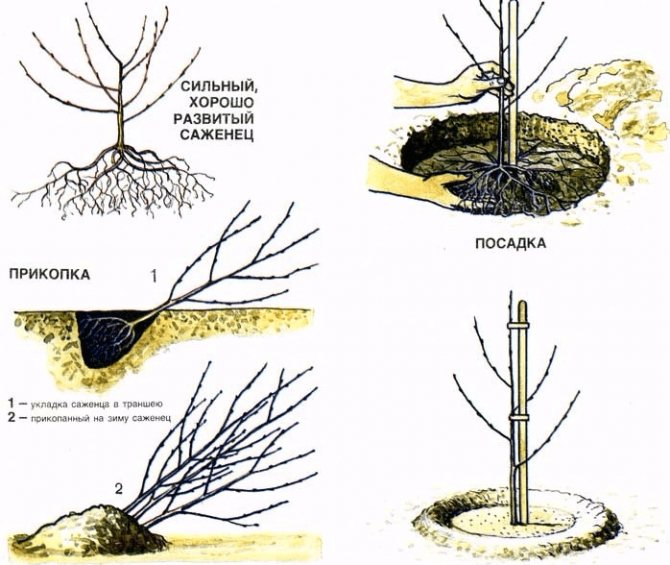

Digging in a seedling will allow it to overwinter until the moment of planting
Planting can be performed in April, but before the stage when the buds begin to bloom at the tree, or from September to the first ten days of October... It is better to start preparing the pit in advance. For spring planting, this should be done in the fall, for autumn planting - a month before the procedure. If it is necessary to prepare several pits, they are located at a distance of 2 m from each other, and the rows are marked every 2.5 m.
Step-by-step process of planting cherries:
- Work begins with digging the site to the level of the shovel bayonet and removing plant debris.
- Then 10 kg of compost or humus, 100 g of superphosphate and 40 g of potassium chloride per 1 m2 are added to the soil.
- Prepare the pit. It should be such that the root system of the plant fits freely in it. The optimal size is 50 cm deep and 60–70 cm wide.
- The excavated soil is mixed with 15 kg of organic fertilizer (compost, quail manure, humus), 40 g of superphosphate, 1 kg of ash and 20 g of potassium chloride.
- If by the time of planting the roots of the seedling are dry, remove the damaged part, then lower the root system for 10 hours in water.
- The pit is filled by a third with a nutrient mixture, making a mound at the bottom. A peg is driven into the center.
- Then a tree is installed and the roots are distributed.
- To avoid the formation of voids, first the seedling is half filled, after which a bucket of water is poured out and the recess is completely filled with soil mixture.
- The root collar is placed 5 cm above the surface. In the future, the soil will settle and it will be at ground level.
- The soil around the tree is tamped, then a hole is dug at a distance of 30 cm from the trunk and 20 liters of water are poured over the cherry.
- After the liquid is absorbed, the area near the seedling is covered with a layer of mulch to prevent cracking of the soil and keep it moist.
- With the help of twine, the cherry is tied to a pre-installed peg.
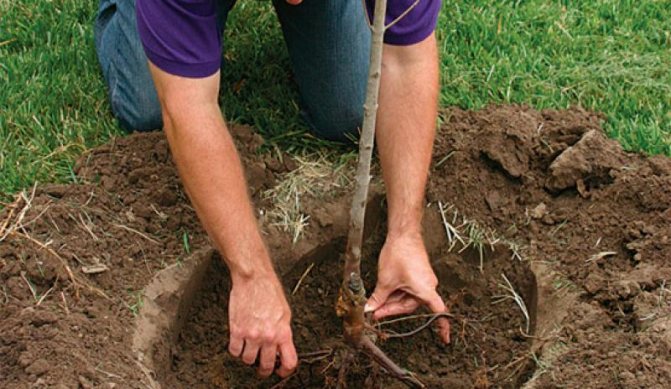

Planting Molodezhnaya is carried out in light loamy soil
Video: Practical tips for planting cherries
Diseases and pests
The youth cherry differs from other varieties in its resistance to diseases. The most dangerous for her is moniliosis, which gradually develops and leads to the drying out of the branches. This disease affects both the whole tree as a whole and some of its parts. After the diagnosis is established, treatment should be carried out, which consists in pruning diseased branches. They are cut off with an indent on healthy parts of 20 cm. The cut shoots are disposed of so as not to provoke a relapse and a new spread of the disease.
The plant may suffer from a monilial burn. It can be seen during the opening of the buds during the flowering period. To prevent the tree from dying, the crown must be sprayed with a special solution. The disease can spread quickly, so you should watch the nearby trees zealously to avoid infection.
Yellow leaves on the tree, which appeared out of season, indicate an onset of the disease. Therefore, it is important to pay attention to this in time, especially if the color quickly acquires a crimson color, which is often a signal of the disease. However, in some cases, the plant simply does not have enough nitrogen.
So, the variety "youth cherry" is the favorite of many amateur gardeners. Since due to self-pollination and a high proportion of ovaries, the plant has a high yield. It is even grown commercially. The variety has excellent taste and excellent firmness of the berry, which allows them to be well stored during transportation. While caring for the plant, the owner does not have to work in accordance with the complex nuances of cultivating the variety. It is enough to get down to business with love and responsibility in order to receive a quick and generous harvest as a reward.
Breeding history
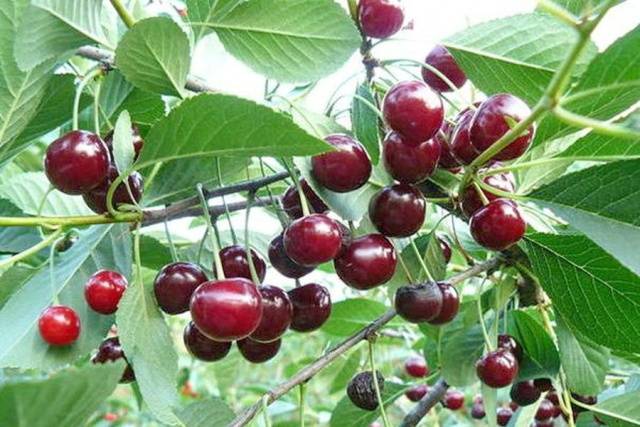

"Molodezhnaya" is a relatively young cherry variety: it was entered into the State Register only in 1993. Its breeding was carried out by the scientists of the All-Russian Institute of Selection and Technology of Horticulture and Nursery Khasan Yenikeev and Saniya Satarova. Cherry "Molodezhnaya" was obtained by crossing the varieties Lyubskaya and Vladimirskaya. The variety is recommended for the Central region of Russia and the Urals.
Description of culture
The height of an adult Molodezhnaya cherry tree is on average about 2 meters, which, in combination with the branches lowered low above the ground, simplifies harvesting. The branches can be intertwined, but usually do not break under the weight of the fruit.
The leaves of the common cherry "Molodezhnaya" have a bright green color, collected in a rounded crown of medium density. The lower part of the leaf is lighter. The bark of the Molodezhnaya cherry has a brownish brown color and darkens over time.
The inflorescence contains 3 to 7 white flowers, each about 3 cm in diameter. Due to the same height of pistils and stamens, this cherry variety is self-pollinating. Cherry blossoms "Molodezhnaya" from 10 to 20 May.
The fruits of Molodezhnaya cherries can reach 1 cm in size, the average weight of a berry is 4-5 grams.The berries are oval in shape and maroon color, dense sweet and sour pulp. Tasting assessment of the fruits of this variety is 4.5 points out of 5.
Read also: Pitted cherry jam step by step recipe quickly and easily from Oleg Mikhailov
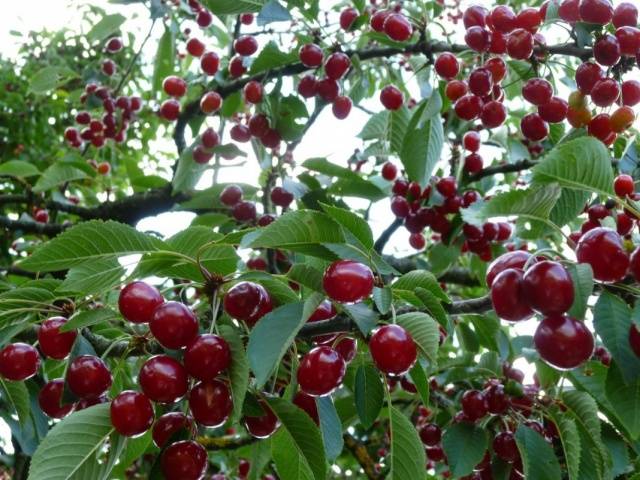

A medium-sized bone is easy to separate from the pulp. Subject to the conditions of collection and transportation and storage, berries of Molodezhnaya cherries can remain intact for up to 15–20 days.
Characteristics
Drought resistance, winter hardiness
The variety is generally characterized by high drought resistance. But immediately after planting and during the fruiting period, it is important to monitor the soil moisture.
"Youth" is referred to as frost-resistant varieties. Flower ovaries tolerate night frosts well.
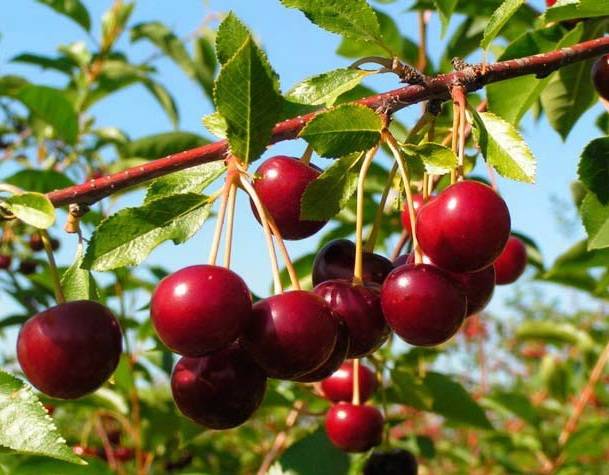

Pollination, flowering and ripening period
Features of crop pollination are of great importance when planning plantings. Up to 40% of pollination "Molodezhnaya" occurs with its own pollen due to equal height pistils and stamens. You can also plant other cherry or cherry trees nearby, which will additionally pollinate Molodezhnaya.
Additional pollinators for Molodezhnaya cherries:
- University;
- Nord-star;
- Lyubskaya;
- Turgenevskaya;
- and different varieties of cherries.
"Molodezhnaya" itself pollinates late cherry varieties well.
The formation of ovaries is noted even on young shoots. Flowering occurs from all buds except the topmost ones. Below is a photo of the Molodezhnaya cherry tree.
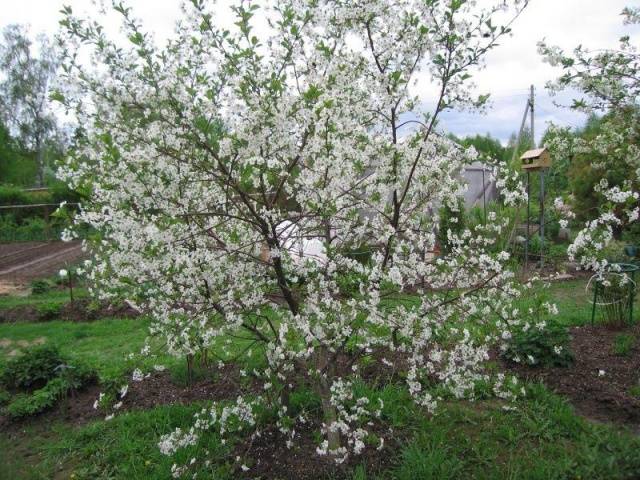

Productivity, fruiting
One Molodezhnaya cherry tree brings from 8 to 15 kg of berries per year. Productivity depends on the age of the plant. The fruits ripen in the third decade of July.
Cherry varieties "Molodezhnaya" begin to bear fruit 3-4 years after planting, continuing to yield another 15-20 years with proper care. Regular pruning of the shoots has a positive effect on yield. In its absence, only peripheral shoots bear fruit.
Scope of berries
Provided the correct collection, transportation and storage of the Molodezhnaya cherry can be successfully preserved. Storage of fruits is possible if the berries are harvested using the shearing method: cutting the berries while preserving the stalk. The integrity of the fetus will not be compromised.
The following rules will help to preserve the fruits of Molodezhnaya cherries for subsequent conservation:
- carefully select the fruits, monitor their integrity;
- do not wash the berries;
- transport and store them in ventilated containers;
- pre-treat the container with potassium permanganate and dry well;
- line the bottom of the container with paper;
- make sure that there are few fruits in the container - no more than 5 cm;
- store the berry at a temperature of + 2 + 4 ° C.
Berries of the "Molodezhnaya" variety are used for making desserts, drinks and juices, for adding to baked goods. Fruits of this variety are suitable for making jams, preserves or preserves.
Disease and pest resistance
Resistance of "Molodezhnaya" to diseases and pests is above average. Most of all, this tree is susceptible to fungal diseases.
Advantages and disadvantages
Cherry "Molodezhnaya" is one of the most reliable varieties for harvesting. Below is a comparative table of characteristics of Molodezhnaya cherries.
Early onset of fruiting
Medium resistance to fungal infections
Good yield (from 8 to 15 kg per tree, depending on age)
Influence of planting site selection on plant growth
Large fruits (up to 10 mm, 4-5 g)
Reduced yield when soil is depleted
Dessert berry taste with a high tasting rating
The need for regular pruning of overgrown shoots
Frost resistance, including flower ovaries
Drought resistance subject to careful care during fruiting
Features of harvesting and storing crops
Cherry Molodezhnaya has an average early maturity, the tree begins to produce berries for 4–5 years. Cherries ripen in the second half of July. The productivity indicators of the variety are quite high. On average, 10-12 kg of fruits are obtained from a tree; under favorable conditions, the amount of the crop can increase to 15 kg. It is recommended to pick berries in the morning after the dew has melted. The fruits are removed with stalks and placed in baskets or small boxes in one layer 5 cm thick.
Cherries can be stored in the refrigerator for up to 3 weeks, in a basement at 10–12 ° C and 90% humidity - about 10 days. The fruits of the Molodezhnaya variety have a universal purpose. They are used to prepare jam, jams, marshmallows, compotes, juices.
For longer storage, the berries are frozen. To do this, they are separated from the stalks, washed, dried, placed in a plastic container or vacuum bag and placed in a freezer. At a temperature of -15–16 ° C, cherries are stored for up to six months.
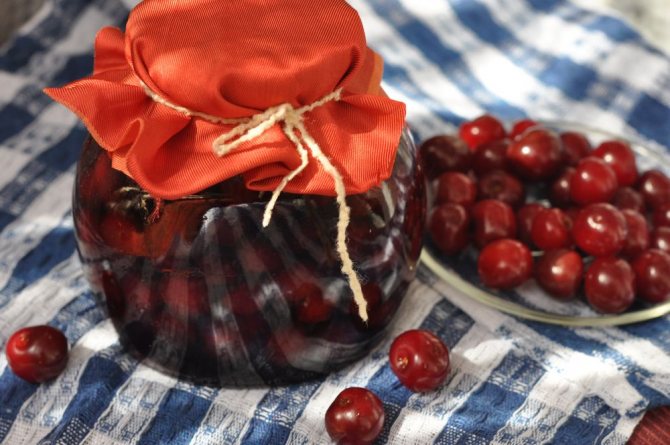

Cherry Molodezhnaya is suitable for desserts and preparations
Landing features
The best time to plant Molodezhnaya cherries is early spring. Planting in spring allows the seedling to take root in the best possible way.
Choosing a landing site
The best cherry varieties "Molodezhnaya" will feel in an unventilated area with good lighting. This can be the southern or southwestern part of the garden near a fence, barn, or house wall. Sandy loam with an acidity of 6-6.5 pH is suitable as a soil.
For planting cherries, a pit 40 cm deep and 80 cm in diameter is prepared in 6 weeks. Organic fertilizing is applied to the bottom of the pit, or soil is dug up in the fall, adding a mixture of fresh compost and phosphorus and potassium fertilizers.
Choosing quality seedlings for planting
In order for the selected seedling to take root well, you need to pay attention to the following details when buying:
- the average height of a seedling should not exceed 70–80 cm for one-year-olds and 110–120 cm for two-year-olds. Tall one-year-olds (up to 1.5 m) are most likely overfed with nitrogen fertilizers and may have reduced winter hardiness, which is especially dangerous for autumn planting;
- the root system should be fibrous and developed, with a root length of 20-30 cm;
- no signs of rot, damage by pests and rodents.
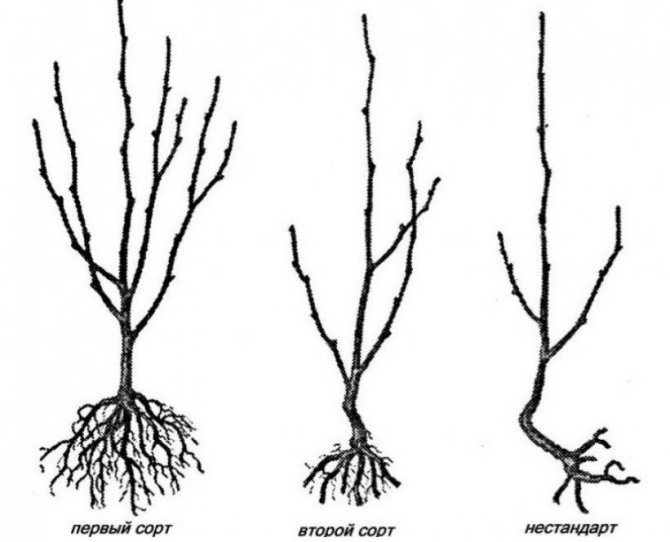

Healthy and high-quality planting material is the key to a good harvest.
Selection and preparation of planting material
Biennial plants with a formed crown are optimal for planting in the ground. A healthy cherry seedling "Molodezhnaya" has:
- height 70-110 cm;
- roots at least 15 cm long;
- elastic and intact branches and roots;
- saturated color fresh leaves;
- intact bark.
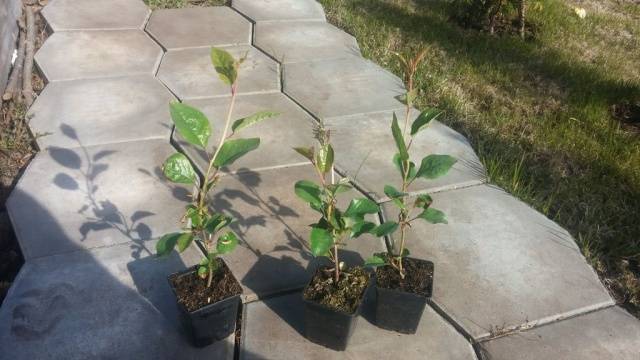

Immediately before planting, all leaves must be removed from the seedling, damaged branches must be cut off. To prepare for planting in the ground, the roots of the seedling are treated with garden varnish or soaked in a clay mash.
Landing algorithm
When planting Molodezhnaya cherries, it is necessary to follow a simple algorithm of actions:
- in advance (at least 6 weeks), dig a hole 40 * 60 cm in size and add organic fertilizing to it;
- before planting, form a mound 10-15 cm high at the bottom of the pit;
- install a 1.3 m high peg in the center of the mound;
- install a seedling next to the peg, spreading its roots along a mound;
- check that the root collar of the plant is 3–5 cm above the level of the site;
- fill the hole with earth, tamp it;
- form a near-barrel hole with a side of the ground;
- tie up a seedling;
- water the plant abundantly;
- mulch the hole after the moisture has been absorbed.


It is important to correctly determine the location of the root collar of the seedling (the place where the roots go into the trunk). A mistake is fraught with the fact that the plant will not take root. The safest way: step back from the top root 3-4 cm up the trunk - this will be the root collar.
Essential Cherry Care Facts
Within a year after planting, the plant needs almost no additional care. Enough timely watering and loosening of the soil. Knowledge about the first signs of the development of a disease in cherries will also come in handy in order to quickly respond and save the tree.
Then you need to remember about the important features of caring for Molodezhnaya cherries, which will help increase the yield:
- timely pruning will protect against a drop in yield: when the plant is overgrown, ovaries are formed only on the outer - peripheral shoots;
- it is recommended to cut about 50 cm of the crown at the top of the tree annually;
- feeding is obligatory twice a year: in the spring with nitrogen fertilizers, in the fall - with potassium and phosphorus fertilizers;
- cherry is hygrophilous: it must be watered often;
- excess moisture can seriously harm, causing fungal infection;
- annual prevention of diseases is important: the treatment scheme is given below;
- adding compost and manure will make the plant healthier and improve its growth;
- for the winter, to protect against rodents, the root system should be covered or blocked.
How to properly prune young cherries:
Care
Watering
The variety is drought-resistant, but picky about watering immediately after planting and at the time of fruiting. The soil under the newly planted tree is kept moist until it takes root and new leaves and twigs appear. Then you can trust the weather, which is generous in the rain. It is much more important to keep the soil loose and free of weeds. The trunk circle is loosened after each watering or rain to a depth of 5–8 cm. If the summer is dry, it is hot for 1–2 weeks, there is no rain, then the tree should be watered with one or two buckets of water.
Fruiting cherries are watered 2-3 times per season: immediately after flowering, at the beginning of the growth of ovaries and after leaf fall (charging). In each case, 3–6 buckets are poured into the trunk circle. The rate depends on the age of the tree and the amount of precipitation. The soil should be moistened to a depth of 50 cm. Charging watering is done only in dry autumn. Cherries are watered at the root, sprinkling is justified only in drought, when the risk of fungal diseases that love dampness and coolness is reduced to zero.
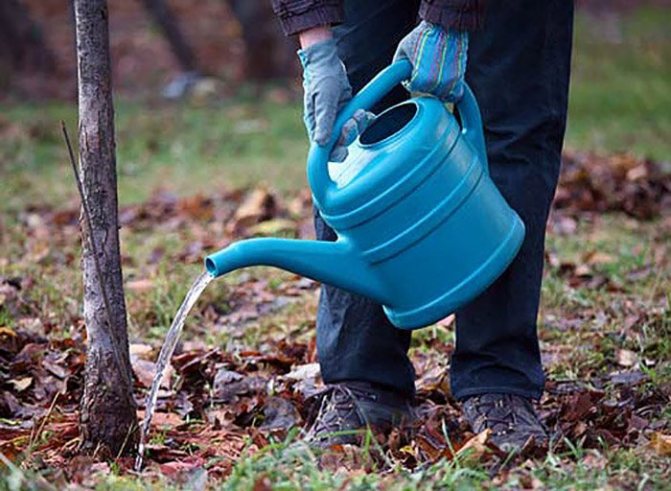

Cherries are watered with watering cans or buckets, the soil is always kept loose
Fertilizers and pollinators of fruiting cherries - table
| Terms of introduction | Fertilizers and application rates | Method of application |
| In autumn | 150-200 g of superphosphate and 60-80 g of potash fertilizers plus 2 buckets of organic matter (manure, humus, compost) every 2 years | scatter on the near-trunk circle and dig to a depth of 15-20 cm |
| In early spring at the first loosening | 50–70 g of urea or ammonium nitrate | sprinkle under the tree and loosen, mixing fertilizer with soil |
| Immediately after flowering | organic fertilizing: 1 part of manure + 5–6 parts of water + 1 liter of ash, leave for a week mineral feeding: 15 g of urea, 15 g of potassium chloride and 25 g of superphosphate dissolve in 10 liters of water | consumption for 1 bush: 5 liters of top dressing, then pour out 2 buckets of clean water |
| 2 weeks after the previous |
Liquid top dressing is introduced into a groove 8 cm deep, dug around the circumference of the crown.
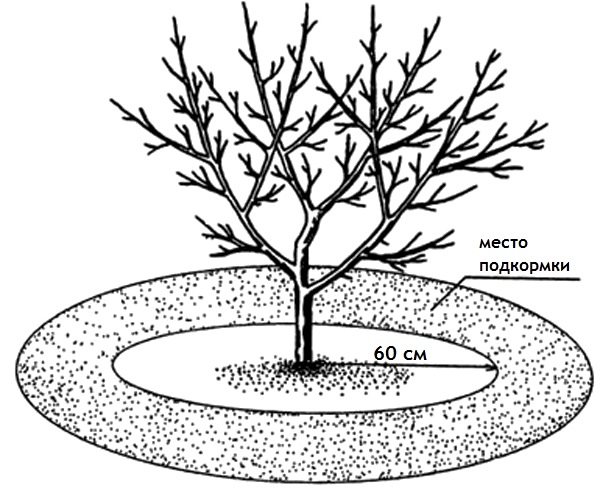

Liquid top dressing is applied to the groove along the crown periphery
Young seedlings do not need additional fertilizing before entering fruiting. The food that was introduced during digging and directly into the planting pit is quite enough for 2-3 years.
Video: caring for fruit trees plus a trick on how to hose at a rate
Pruning
If it is important for pome crops to form the crown correctly, then for stone crops, thinning is necessary. In addition, sanitary pruning is essential for any tree.
What branches need to be cut from Molodezhnaya cherries:
- broken, frozen, diseased;
- thickening: growing inward crowns (towards the trunk), criss-crossing, rubbing;
- fattening - growing vertically upward from the main branches;
- curves;
- too large annual increments (more than 50 cm), they are shortened by a third.
Pruning is carried out in early spring. Slices larger than 1 cm in diameter are treated with garden varnish, special paste, oil paint, plasticine.
Video: pruning cherries in early spring
Preparing cherries for winter
In addition to the already mentioned autumn watering and feeding, preparation for winter includes: whitewashing and covering the trunk and skeletal branches. Ordinary lime in high concentration can burn the tender bark of young trees, so for whitewashing it is better to buy special garden lime, which is sold in stores for summer residents. The white color reflects the sun's rays well, the bark will be protected from burns, gum flow will not appear, the cherry will not get sick. The trunk is whitewashed to the first skeletal branch, as well as the lower skeletal branches by a third of the length.
Young cherries are resistant to frost, but not to rodents, therefore, the stem from the ground and to the height of the snow cover, as well as branches that can be reached by mice and hares, are tied with spruce branches, wrapped with nylon tights or breathable covering material. In spring, this protection must be removed immediately after the snow melts.

